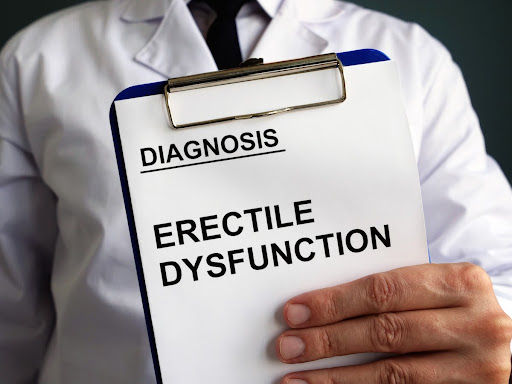 ED or erectile dysfunction, the consistent inability to obtain or sustain an erection sufficient for sexual intercourse, is more common than you think. Did you know that 50% of men between the ages of 40 and 70 have ED? ED covers a variety of physical inabilities from a total inability to achieve an erection or ejaculation, to an inconsistent ability to do so, to a tendency to sustain only very brief erections. No matter how slight the inability, it’s of great concern to most men. Here’s the bad news, the risk of erectile dysfunction increases markedly with age. So what can you do to lessen your risk? We’re glad you asked.
ED or erectile dysfunction, the consistent inability to obtain or sustain an erection sufficient for sexual intercourse, is more common than you think. Did you know that 50% of men between the ages of 40 and 70 have ED? ED covers a variety of physical inabilities from a total inability to achieve an erection or ejaculation, to an inconsistent ability to do so, to a tendency to sustain only very brief erections. No matter how slight the inability, it’s of great concern to most men. Here’s the bad news, the risk of erectile dysfunction increases markedly with age. So what can you do to lessen your risk? We’re glad you asked.
What Are the Risk Factors of Erectile Dysfunction?
Knowing the risk factors that increase your chances of suffering from ED may help you make better health decisions. Read over this list and you will realize that some things you will have control over, others, you won’t.
Erectile Dysfunction Risk Factors Include:
- Medications – some medications used for high blood pressure, depression, and hormone suppression
- Illicit drugs
- Hypertension
- Diabetes
- Heart disease
- Elevated cholesterol or lipids
- Atherosclerosis (hardening of the arteries)
- Obesity, and other conditions that impair the blood flow or nerve supply to the penis
- Heavy alcohol use
- Depression/anxiety/stress/fatigue/relationship conflicts
- Overstimulation/desensitization such as excessive use of pornography
The Emotional/Personal Effects of ED
Because ED is a very personal condition, oftentimes it can have emotional or psychological causes in combination with physical problems. Physical causes of ED are more common in older men. For younger men, emotional issues are typically the cause. ED affects intimacy, so it is important for men to address this issue with their partner and include them in the evaluation and discussion of treatment options. ED essentially becomes a shared condition in many ways because you are not the only person it is affecting. It is important to keep this in mind when deciding which treatment will fit your lifestyle and intimacy needs best.
Many Risk Factors for ED Are Controllable
The good news is that many of these risk factors are in your control. Physical exercise tends to lessen the risk of ED. Eating healthier and increasing physical activity usually lead to weight loss which can improve certain conditions in certain individuals such as diabetes, hypertension, heart disease, and high cholesterol. Furthermore, smoking accelerates atherosclerosis and has been found to be a strong risk factor for developing ED or impotence. These are all great reasons to eat healthier, get more exercise and stop smoking…sound familiar? To put it bluntly, it is unrealistic to remain an obese, hypertensive, smoking diabetic male, and expect a healthy sexual experience.
What Are My Treatment Options for ED?
Medicine: Treatment for ED was revolutionized after the introduction of sildenafil (Viagra), the first effective pill for the treatment of ED. More choices have become available including vardenafil (Levitra) tadalafil (Cialis) and avanafil (Stendra). These medications work best for men who can achieve at least partial erections.
Vacuum Erectile Device: This is a medical device that fits over the penis and causes negative pressure to pull blood into the penis. A soft band is then placed at the base of the penis to keep the blood from escaping. It is removed after intercourse. This is the most cost-effective and non-invasive method of treating ED.
Penile Injection Therapy: Using a very small syringe and needle, medication can be injected into the side of the penis which acts to dilate the penile arteries. This can be an effective treatment for selected men who are dexterous and can visualize their penis adequately. Instructions and a test dose in the office are important before patients are advised to do it on their own. If the dose is too much, then priapism (prolonged and painful erection) is possible. Men with erections lasting more than three hours should seek medical attention immediately.
Penile Prosthesis: This is a device that is surgically implanted into the penis. There are two types. A semi-rigid device or the more common variety that inflates for intercourse and then deflates. These are very safe and effective but may result in some penile shortening.
ED Is Treatable with Lifestyle Changes and Medical Evaluation
The good news? ED is a treatable condition. It is also a condition that can be exacerbated or mitigated by everyday decisions you make that affect your lifestyle. If you’re looking for incentive to live healthier, this should be a big one. A healthy lifestyle that includes exercise, weight control, and avoiding cigarette smoking is the best way to postpone the loss of erections. It is important to undergo a thorough evaluation to address any health issues that may be risk factors that lead to ED.
The urologists at KCUC can diagnose ED and explain all of your options. Don’t live with ED. We have treatment options. Definitely do what you can on your own to become healthier, but come see us for your ED issues and we can help get you back to enjoying life and regaining intimacy with your partner.
